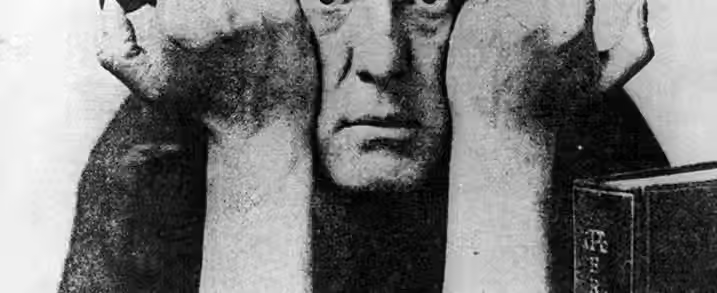Thoth deck: Aleister Crowley's whicked child
The Thoth Tarot is often called Aleister Crowley’s wicked child, and for good reason. Crowley was not a man who played it safe. Born in 1875 in England, he grew up in a strict religious household, rejected it entirely, and threw himself into a life that mixed mysticism, sex, art, and rebellion in equal measure. He travelled widely, studied magic with the Hermetic Order of the Golden Dawn, climbed mountains, wrote poetry, and developed his own religious philosophy called Thelema.
Crowley enjoyed shocking people. The newspapers of his time labelled him “the wickedest man in the world,” a title he didn’t fight. He leaned into the role of provocateur, writing openly about taboo subjects and filling his work with coded symbolism that blurred the line between art and ritual.

The Thoth deck was born from Crowley’s desire to create a tarot that carried his own philosophy and the depth of the Western esoteric tradition. In the late 1930s he asked Lady Frieda Harris to illustrate it. Harris agreed, even though she had little experience with tarot at the time. Crowley gave her detailed instructions for every card, combining astrology, numerology, alchemy, the Kabbalah, and his Thelemic teachings. Harris painted each image in layers, reworking them over and over until they matched Crowley’s vision. The project took five years to finish.
While the Rider Waite Smith deck is built for clarity and accessibility, the Thoth is unapologetically complex. The art in Rider Waite Smith is straightforward, with clear human figures and scenes that are easy to interpret. The Thoth uses abstract shapes, bold colors, and dense symbolism. In Rider Waite Smith, the minor arcana show illustrated scenes. In the Thoth, the minors use symbolic arrangements and carry names like “Strife” or “Victory” that set the mood for the card.
The major arcana also differ. Crowley changed some names entirely. Justice became Adjustment. Judgement became The Aeon. Strength became Lust. These changes reflect his own interpretations and the structure of Thelema. The meanings themselves can shift as a result, which is why a Thoth reading often feels more psychological and archetypal than a Rider Waite Smith reading.
Rider Waite Smith gives you a story you can read at a glance. Thoth challenges you to slow down, decode the layers, and see how the symbols connect. It is not the easiest deck to learn, but it rewards the effort with readings that go far beyond the surface.
Thelema and Kabbalah
To understand the Thoth deck fully, you need to know that it was built as a reflection of Crowley’s spiritual system, Thelema. Thelema is based on the idea of discovering and following your “true will,” the path in life that aligns with your deepest purpose. The phrase most linked to Thelema is “Do what thou wilt shall be the whole of the Law,” which, in Crowley’s view, was not about acting without care, but about living in complete alignment with your inner calling.
The Thoth Tarot also draws heavily on the Kabbalah, a Jewish mystical tradition that maps spiritual concepts onto a symbolic structure called the Tree of Life. In this system, the Tree is made up of ten spheres, called sephiroth, connected by twenty-two paths. Each tarot card has a place within this structure, connecting it to specific spiritual qualities, numbers, and energies.
Crowley used the Tree of Life as a framework for the Thoth deck. Every card has an exact position, linking it to both a sephira and a path, as well as an astrological association. The major arcana line up with the twenty-two paths, while the minor arcana connect to the sephiroth through the four suits. This design means that when you read the Thoth, you are not just pulling random cards. You are interacting with a carefully mapped spiritual system that ties together mysticism, astrology, numerology, and philosophy.
This combination of Thelema and the Kabbalistic Tree of Life is one of the reasons the Thoth feels so different from Rider Waite Smith. It is more than a deck of cards. It is a full symbolic language, and every card is a doorway into a wider set of teachings.

The Tree of Life
The Tree of Life is a symbolic diagram from the Kabbalah, a Jewish mystical tradition. It is made up of ten spheres, called sephiroth, linked together by twenty-two paths. Each sphere represents a different aspect of existence, from the divine source at the top to the physical world at the bottom. The paths between them show how those aspects connect and how energy moves through creation.
Moving from Rider Waite Smith to Thoth
switching from Rider Waite Smith to Thoth means changing how you look at the cards. Thoth is not built around small illustrated scenes. It uses color, shape, and symbolic placement to show meaning. Instead of asking what is happening in a picture, you focus on the type of energy the card is expressing.
Reading with Thoth takes more time. The details are dense and often layered on top of each other. You cannot glance at the card and get everything. The more you sit with it, the more you see.
The deck is designed to connect ideas across a reading. One card can open up links to other areas of life that you were not asking about. This can make readings expand naturally, even when you start with a narrow question.
Begin with small steps. Pull one card each day to learn its feel. Then use simple two or three card spreads. Spend time looking at how the cards interact, not just what they mean alone.
Treat Thoth as its own system. Do not expect it to respond like Rider Waite Smith. Give it space to teach you its language and it will reveal more each time you use it.
